Often wrongly labelled as a league equivalent to world football’s retirement home, the MLS has been through a massive glow-up in recent years.
Previously, clubs in America’s top-flight division focused largely on branding their franchise, bringing massive names from Europe such as the former Liverpool great Steven Gerrard and Arsenal legend Thierry Henry towards the end of their careers.
However, now, there is a much greater emphasis on signing young talents from parts of South America, Mexico and Africa than ever before while also maintaining the attraction for big European players.
The club that epitomises this the most are LAFC. Coached by the ex-Hannover captain Steve Cherundolo, the Los Angeles-based club have managed to perfectly blend youth with experience, stirring the concoction around with mega European quality.
Cherundolo has already guided LAFC to the top of the Western Conference as well as to the summit of the overall MLS table, and in the summer window, the Black and Gold have already added Gareth Bale and Juventus luminary Giorgio Chiellini to the squad.
This tactical analysis article will be a scout report of LAFC under the former USA international. The piece will be an analysis of the tactics employed by Cherundolo, looking at why LAFC have been the best side in the MLS in 2022.
A passing of the torch
At the end of last season, after missing out on a playoff spot by finishing ninth in the Western Conference, LAFC parted ways with the reliable Bob Bradley who had been in charge since 2017.
The former Swansea City boss was very rigid with his formation choices during his tenure in LA. The 4-3-3 was always Bradley’s go-to structure. In 2019, LAFC used this conventional shape in 88 percent of their games. This increased slightly to 91 percent in 2020. However, it was clear that things turned sour in 2021 when Bradley began sifting through formations, with the 4-3-3’s usage dropping drastically to 33 percent:
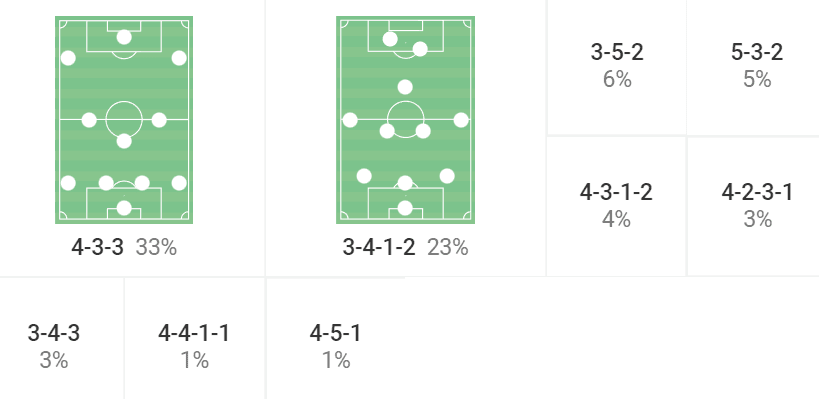
After parting ways with Bradley, the newish club took a massive risk by appointing Cherundolo. The American legend had a plethora of coaching experience, working as the assistant manager of VfB Stuttgart under the guidance of Tayfun Korkut as well as on Dave Sarachan’s coaching staff with the US national team.
However, the 43-year-old had no experience of managing in the professional game apart from one year with the Las Vegas Lights in 2021 where he left with a harrowing 18.8 percent win record.
Upon arrival in the City of Angels, Cherundolo wanted to bring back a consistent use of the 4-3-3, believing that the Pep Guardiola-inspired formation best suits the players at his disposal, as Bradley did for most of his reign until the wheels spun off the tracks last season.
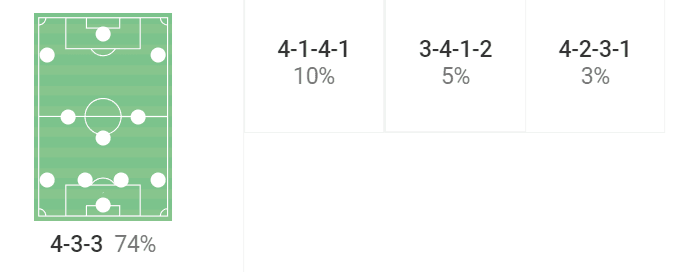
The 4-3-3 and its more conservative brother, the 4-1-4-1, have been used in 84 percent of LAFC’s matches so far in all competitions in 2022. Nevertheless, Cherundolo has been no stranger to employing the more cautious 3-4-1-2 or 4-2-3-1 in certain matches, depending on the opposition at hand.
With the 4-3-3 very much back in full motion in Los Angeles, Cherundolo’s side have cracked on to become the most menacing team in the MLS once more. Now, let’s take an in-depth look at how the new boss has used his 4-3-3 to great success.
Playing out from deep
Not only has the MLS seen an overhaul in recruitment strategies used by clubs, but there has also been somewhat of a tactical renaissance in recent years.
With the importation of European and South American coaches, the league has seen radical changes in terms of the strategies used by sides on the pitch. Tacticians such as the New York Red Bulls’ Gerhard Struber and Jesse Marsch as well as a Marcelo Bielsa like Matías Jesús Almeyda have all played their part in revolutionising and diversifying the tactical profile of the league.
Of course, the rise of Guardiola in the European game certainly contributed to this too, showing the world that passing out from the back rewards with far more riches than cataclysms.
Keeping with this trend, LAFC like to play out from the back from goal-kicks, with Cherundolo placing a hefty emphasis on his goalkeeper and centre-backs being comfortable with the ball at their feet – which they certainly are.
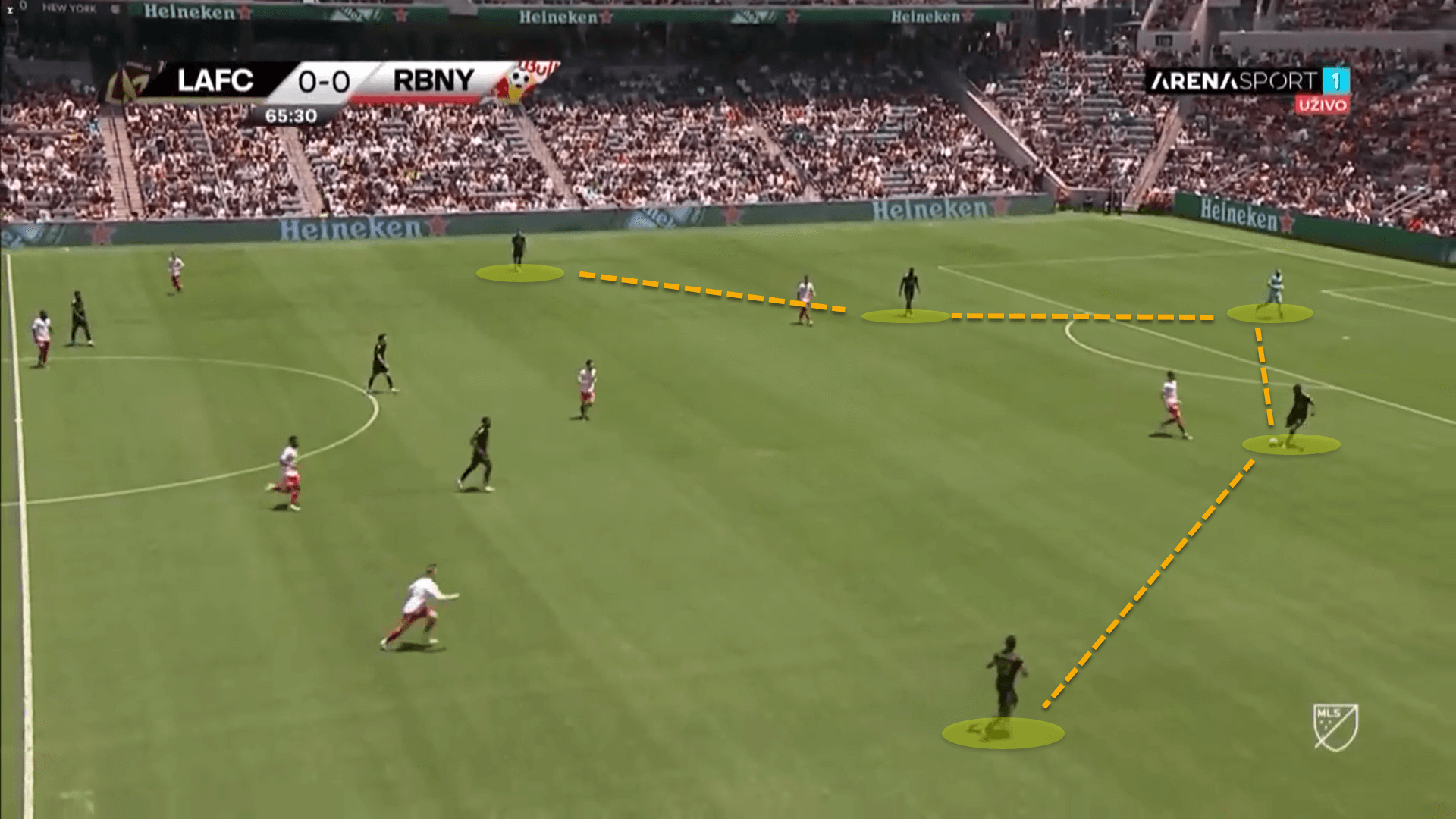
LAFC’s passing network from their most recent outing against Dallas, which ended in a 3-1 at the Banc of California Stadium, shows just how heavily involved their goalkeeper is, with a particularly strong link to the right centre-back in this game.
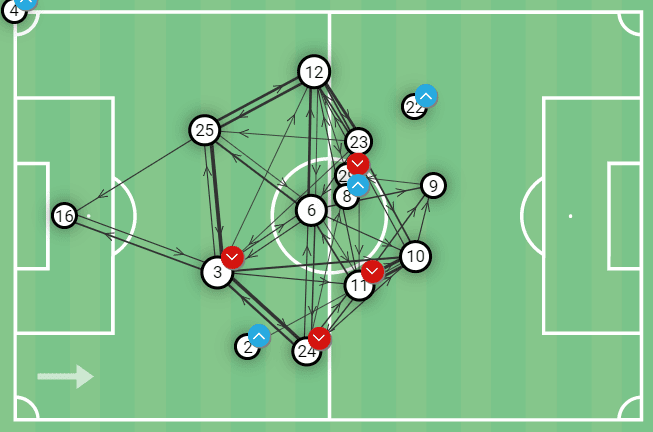
With LAFC’s 53 percent average of possession per game in the MLS this season, building out from the goalkeeper has been an integral aspect of Cherundolo’s coaching philosophy.
During the build-up phase, as LAFC are attempting to bypass their opponent’s high press, the fullbacks push higher while the two central defenders move wider, facilitating the goalkeeper being able to drop between them.
LAFC build up through their fullbacks who excel at receiving the ball in a negative position, turning, and combining with the nearest midfielder and winger in order to progress higher up the pitch.

However, unlike quite a lot of managers that are hell-bent on keeping the ball on the floor, the American is alright with his side going long in order to be unpredictable.
LAFC have played 35.15 long passes per 90 in the MLS and are the second-lowest ranked side in this metric. Nevertheless, there are still times when the goalkeeper, or centre-backs, do pump the ball long towards the frontline who can challenge for the second ball high up the pitch.
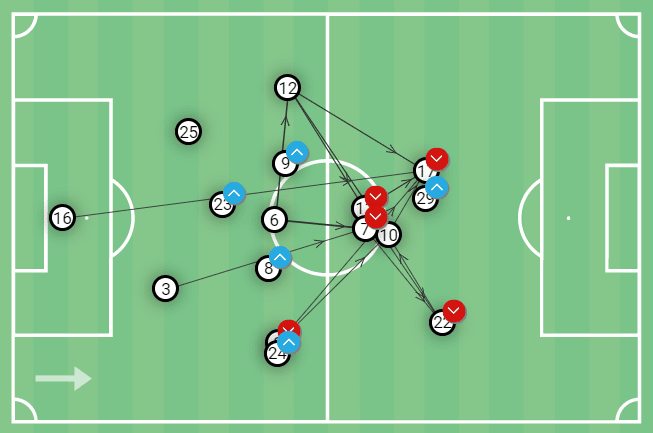
This was evident from LAFC’s forward passing map against NYRB. Struber’s Red Bulls were applying their usual high press and causing some issues for LAFC in the first phase of the attack. Instead of stubbornly persisting with playing out from deep, the goalkeeper and centre-backs were instructed by Cherundolo to hit some longer balls to the forward line.
In fact, 13.21 percent of LAFC’s overall passes in that game were long passes, the second-highest this number has been for the Los Angeles club this season.
But this isn’t a weakness – quite the opposite. It proves a willingness to be tactically flexible from the side while staying unpredictable. LAFC are capable of playing long and short, allowing them to be adaptable in games, regardless of what the opposition throws at them.
Big switches of play
In a similar manner to their build-up play, LAFC create a lot of wide overloads in the final third in order to break teams down who are sitting in deeper defensive blocks.
The 4-3-3 naturally facilitates wide triangles because of the shape and so the wingers can combine with the nearest central midfielders and advanced fullbacks in order to get in behind the opponent.
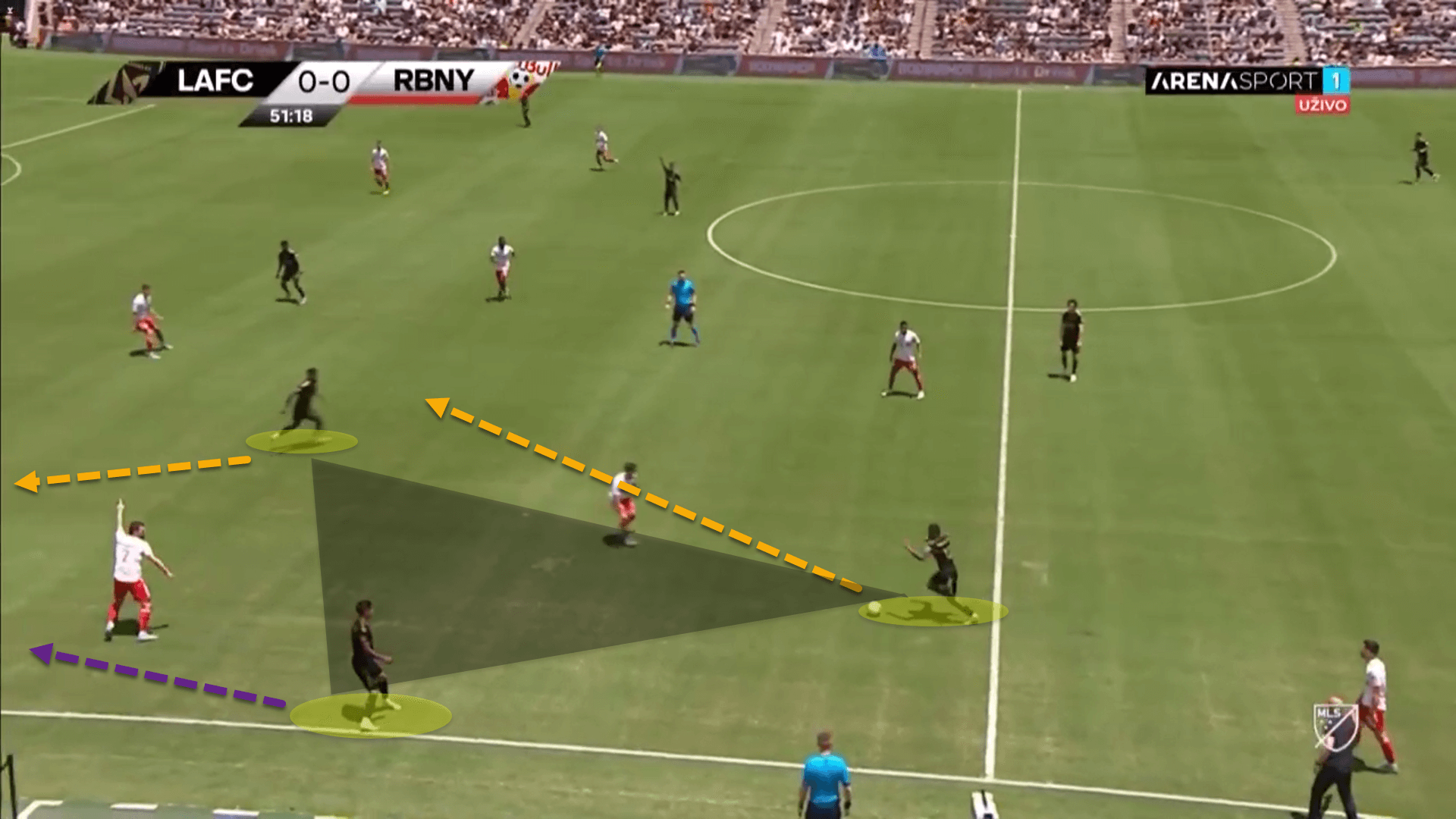
In instances where these triangles or wide overloads are proving insufficient to get through the opposition’s defensive block, LAFC rely on massive switches of play to quickly swing the ball to the other flank.
This is common for quite a lot of possession-based teams. As the defending side will have dropped themselves across to the ball-side in order to defend in numbers, it leaves a lot of space over on the opposite wing. If the play is switched successfully, the attacking team can quickly attack this space before their opponent shifts back across.

Here, for instance, in LAFC’s most recent league clash against FC Dallas, Cherundolo’s men were unable to break through the Texans’ stern 4-5-1 low block and so played the ball back inside towards Sanchez who lofted it outward to the left-back who was in acres of space.
Of course, integral to a team consistently completing these switches of play is having someone who can do so on a continuous basis. Ilie Sánchez is Cherundolo’s man for the job. Despite being the team’s pivot player, Sánchez sits under the play when LAFC are in advanced positions and acts as a deep-lying playmaker.
The Spaniard has averaged 9 passes to the final third per 90 this season for LAFC in all competitions with an accuracy of 80 percent. He is also averaging 1.14 passes to the penalty area. The following image displays all 13 of his passes to the final third against Dallas on Wednesday night, as Sánchez ended the game with 93 percent passing accuracy:
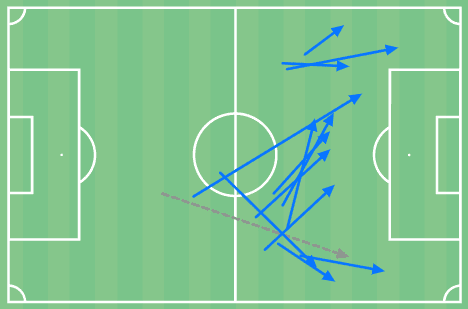
Sánchez makes LAFC tick, just as he did with Sporting Kansas City for five years. It’s no surprise that the 31-year-old was coached by Pep Guardiola at FC Barcelona B in the 2007/08 season.
Whether it be through a wide triangle or switch of play, when LAFC do get the opportunity to cross the ball in the final third, the burden of creating chances is placed heavily on their fullbacks who put balls in from quite wide positions, especially left-back Diego Palacios who will be at the World Cup with Ecuador in November.
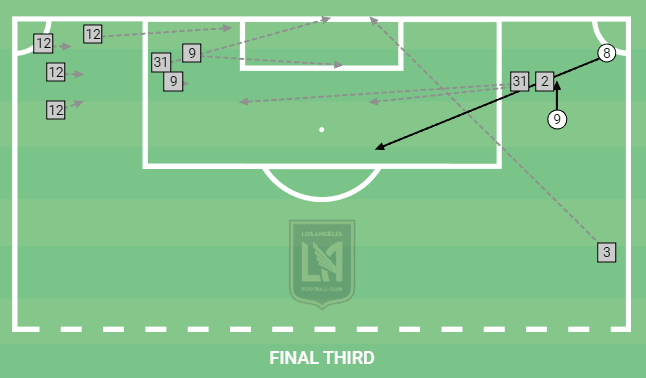
Unfortunately, LAFC are relatively disastrous from crossing positions and have completed merely 25 percent of their crosses on average this season, one of the lowest numbers in the MLS for this metric.
Overall, LAFC are living way beyond their means up front. This season alone, they have accumulated a total of 30.00 expected goals, scoring 37, the highest goalscoring side in the US’ top-flight division. This may not be sustainable long-term despite how efficient they have been up front, although the addition of Gareth Bale can only help them in the final third.
Quick and effective transitions
Despite being a possession-heavy side, LAFC are immaculate in transition and cause serious damage to their opponent. This has been arguably the most impressive tactical change under Cherundolo. The Western side complete 3 counterattacks per 90, with roughly half ending in a shot on goal.
However, counterattacks have to originally stem from the defensive phases. LAFC are also a side that presses high, trying to get in the face of the opposition in order to win back possession as far up the pitch as possible.
This season, LAFC have boasted a Passes allowed Per Defensive Action (PPDA) of 9.15, one of the lowest in the MLS.
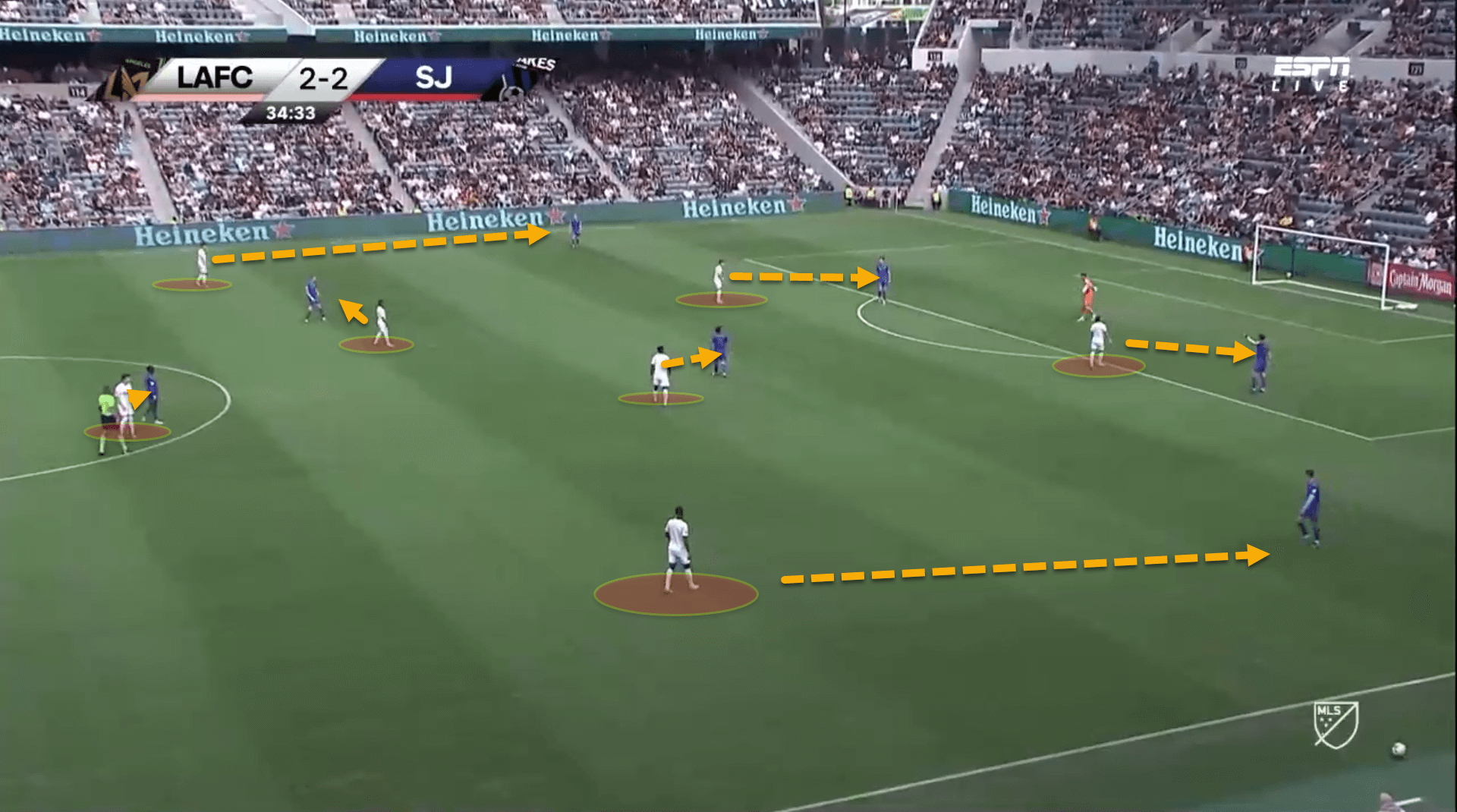
In the high block phase, LAFC go with a mix of zonal and man-oriented as they look to win the ball in the final third.
In the above scenario, the Black and Gold have set up in a strict man-to-man fashion but typically, the single-pivot, Sánchez, operates in a more zonal capacity, picking up any of the opposition’s players that are looking to receive the ball in front of LAFC’s backline.
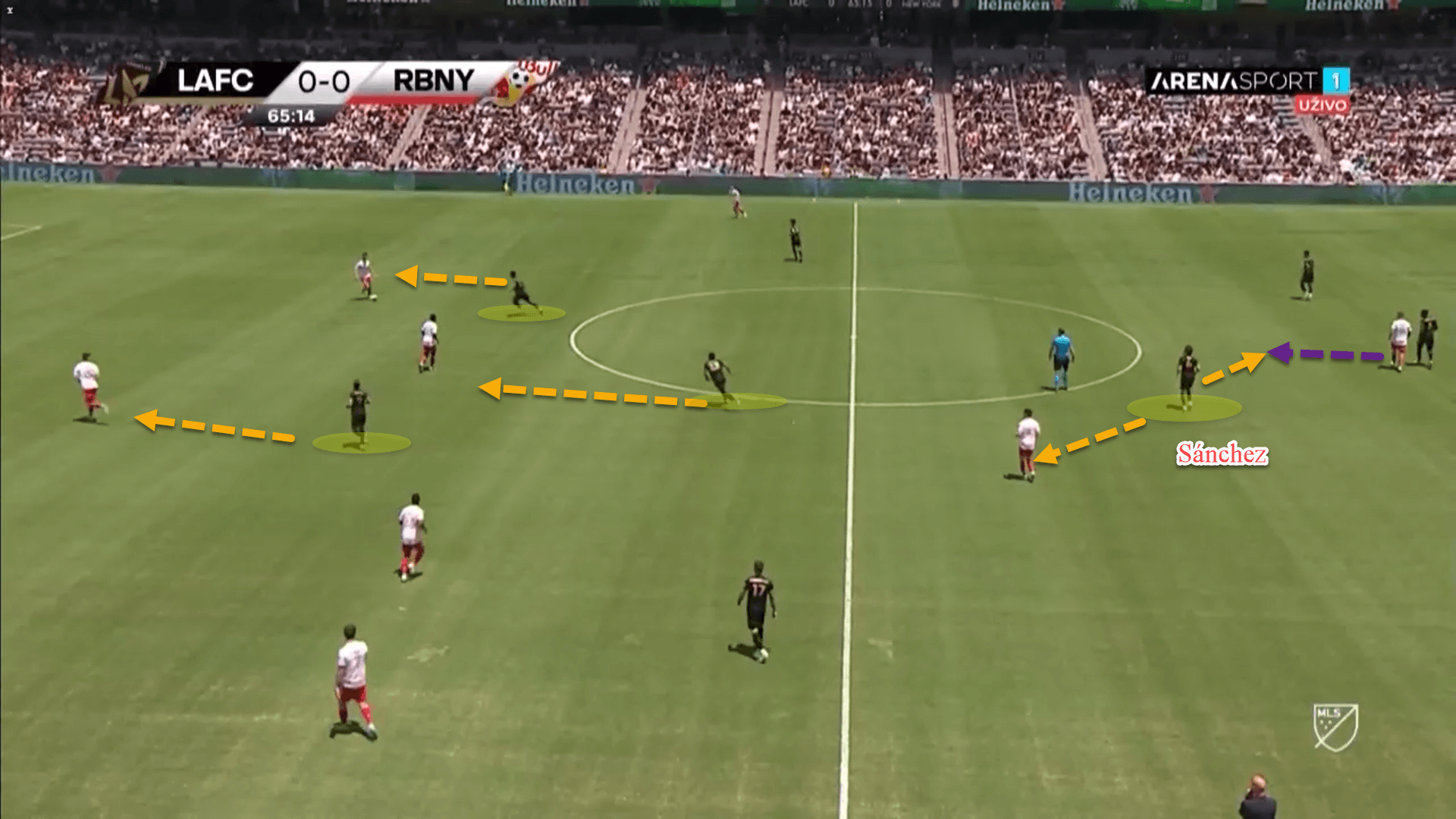
Despite using a 4-3-3 as their base formation, LAFC’s shape in the high pressing phase tends to resemble a 4-4-2 diamond, as is evident from the picture above.
However, as the Los Angeles-based club drop back to become a deeper, more compact defensive unit, the shape changes to a 4-1-4-1. The structure is very narrow, horizontally and vertically, and the players are told to shift to the ball side, remaining as close together as possible, although this often leaves a lot of space on the far flank for the opposition.
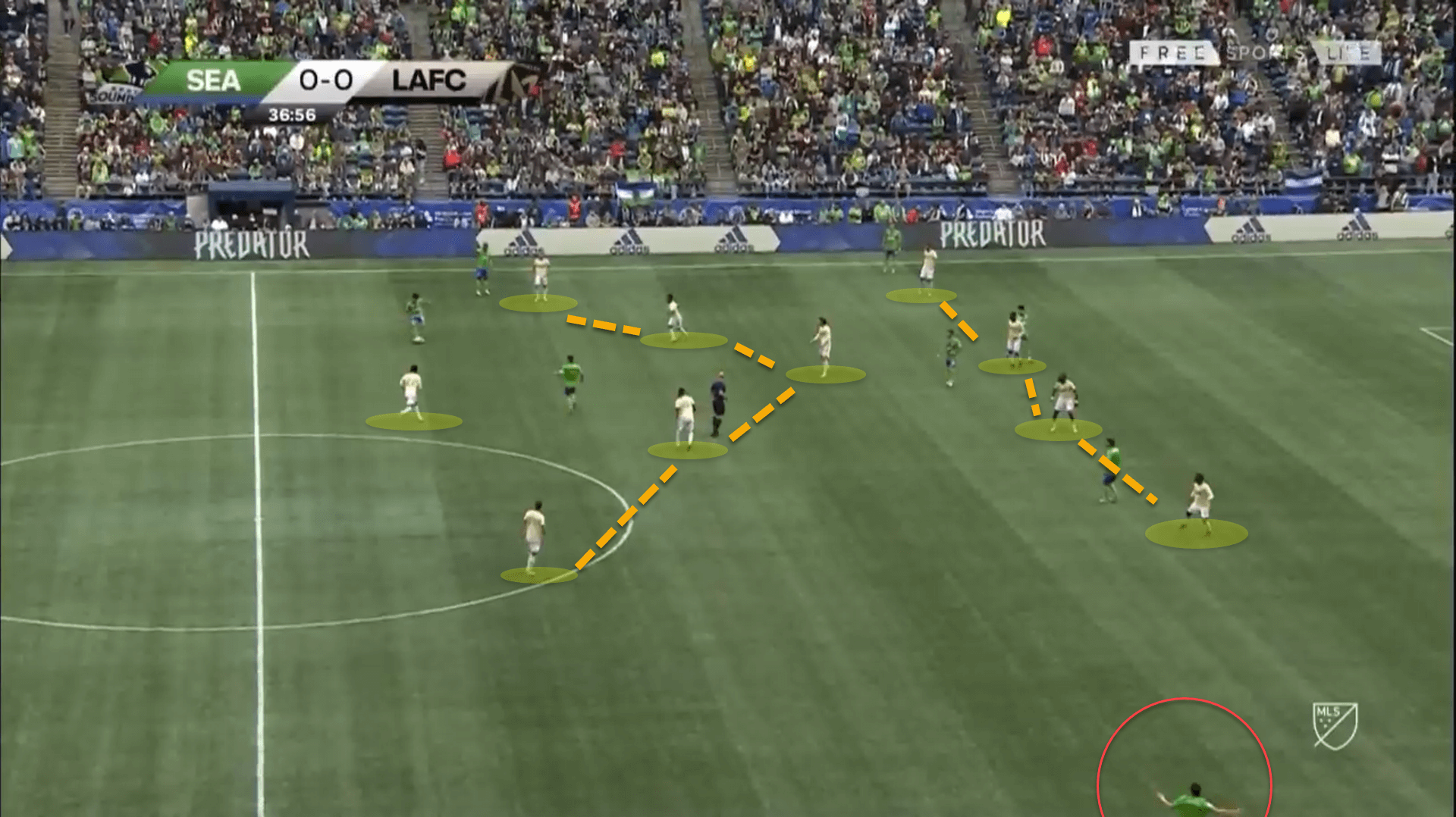
Cherundolo has the side very well-drilled defensively as LAFC have conceded just 0.97 goals per 90 in the league so far, the second-lowest ranked team in this metric.
More impressive is LAFC’s ability to turn defensive situations into attacking opportunities, using their speed and quality in the attacking departments to take advantage of space behind the opposition’s backline.
Creating goalscoring chances from low block scenarios has become increasingly difficult in the modern game due to the development of rest defence structures. Teams are far more capable of preventing counterattacks high up the pitch through counterpressing. But this doesn’t seem to be much of an issue for LAFC.
When the Black and Gold regain possession of the ball, LAFC quickly find runners who are sprinting into space out in the wide areas. As teams push their fullbacks/wingbacks high, there is always space out there to be exploited.
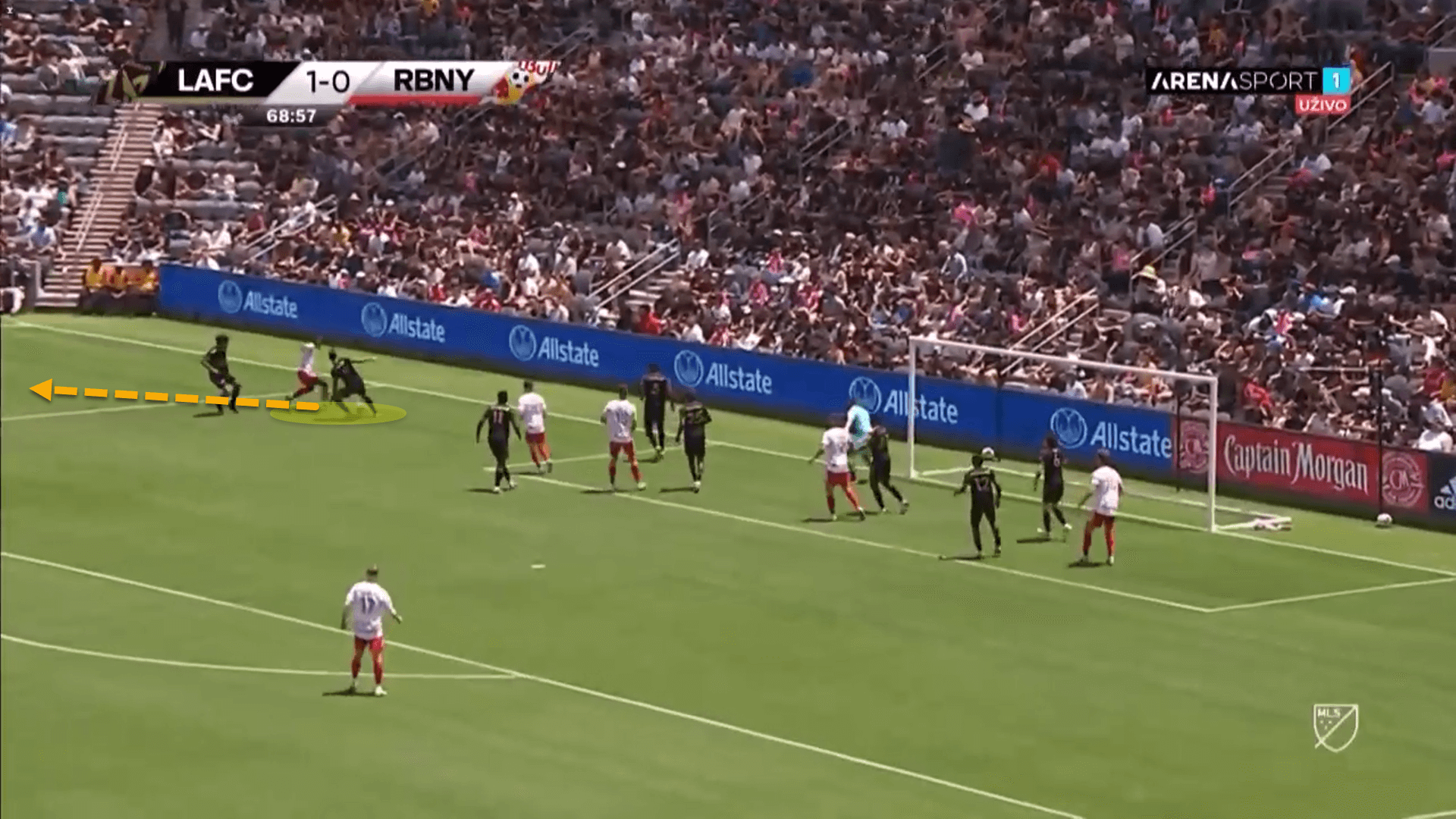
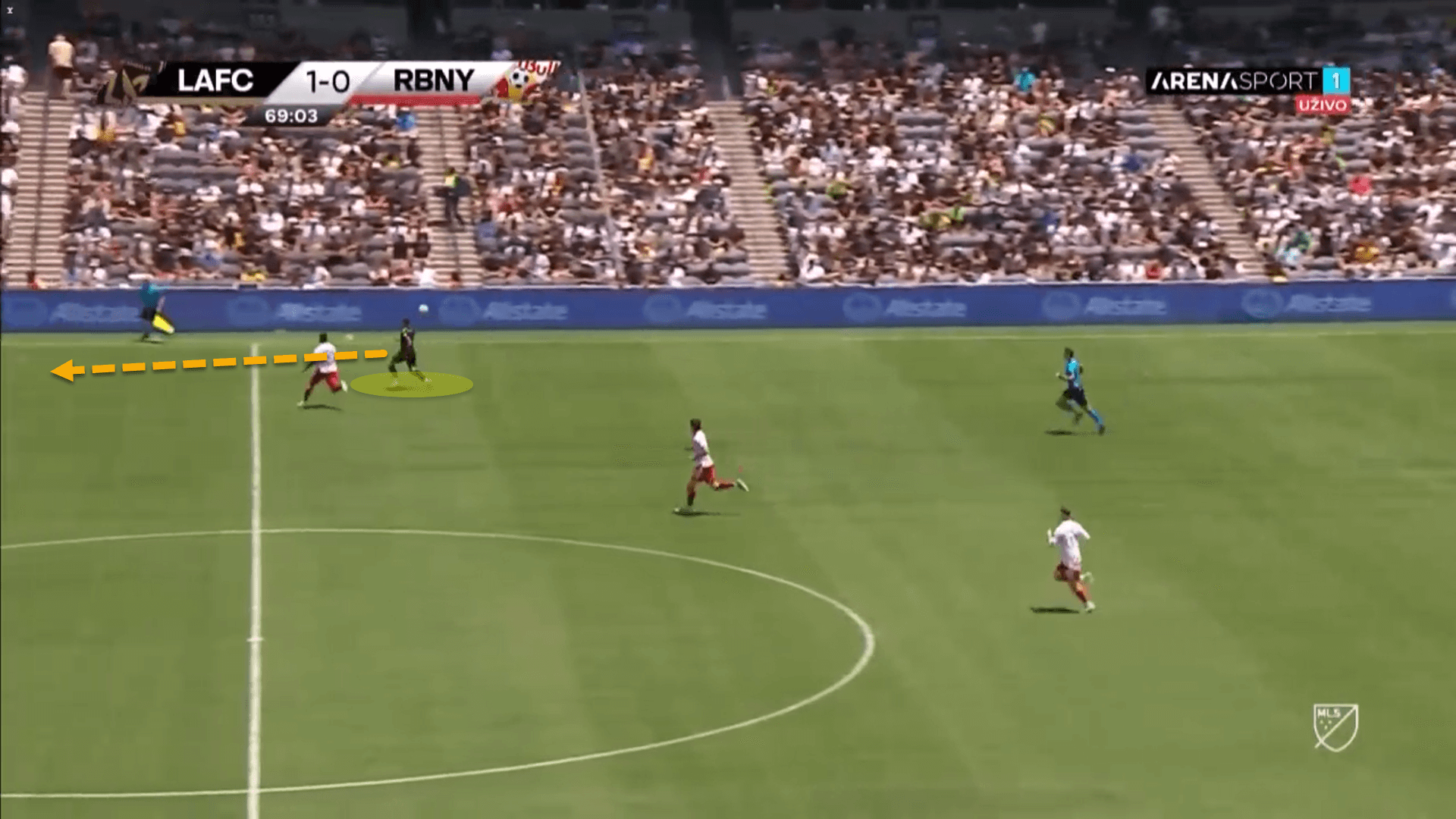
In this example, LAFC were defending in a low block and were pinned back by the NY Red Bulls, being forced to scramble to defend their own goal from danger.
But in the end, an LAFC defender managed to nick the ball, quickly playing directly into the right channel where one of the forwards began running as there was a plethora of space to be taken advantage of.
The forward pushed the ball past the onrushing defender, and eventually, LAFC finished off the attack by putting the ball into the back of the net to score their second of the game.
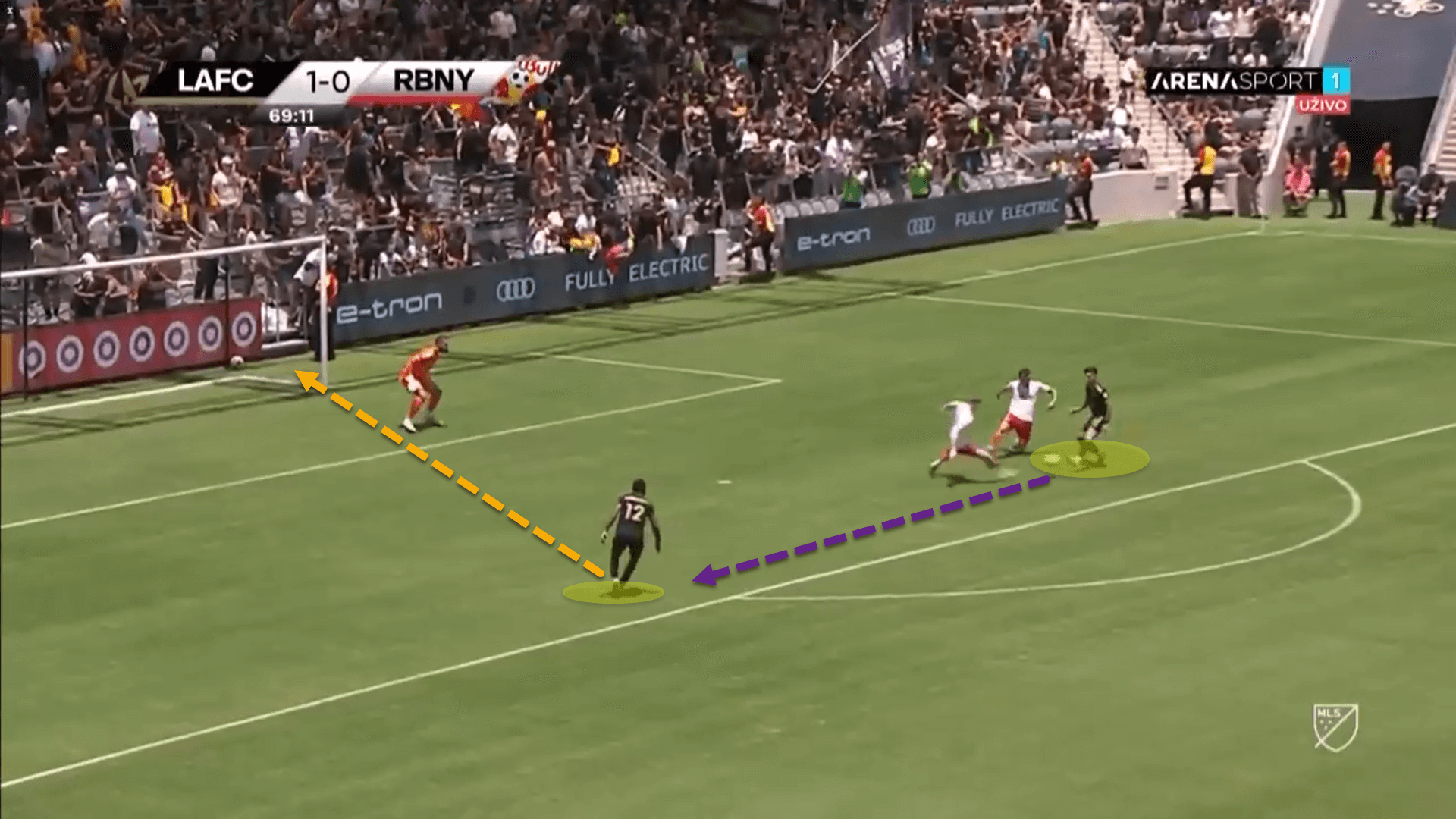
Within fifteen seconds of winning back the ball, almost at the byline, LAFC had scored at the opposite end. The key to low block counterattacking is doing so as fast as humanly possible while being efficient. It seems basic. It is basic. But LAFC do so extremely well.
Imagine the damage a player like Gareth Bale could cause teams in the MLS with his pace on the break!
Conclusion
To be a successful side, a team needs to be well-structured and effective in all of the four main phases of football: in possession, out of possession, attacking transitions and defensive transitions.
LAFC tick all of these boxes and so it’s no wonder why they are top of the overall MLS table while scoring the most goals in the league and conceding the fourth-least.
With Chiellini and Bale now added to the squad, Cherundolo’s side could be unstoppable for the remainder of the campaign, playing football in an impressively flexible manner.






Comments